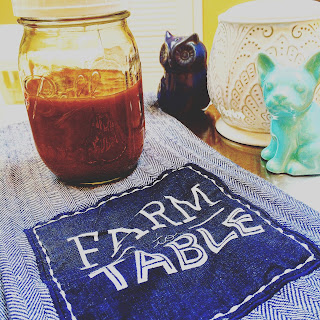I love my city. RVA has a special place in my heart.
Richmond, VA is my hometown. In light of that, as Richmond is becoming more and more of a beacon on the map, it is great to know a bit about an area one may visit.
Thankfully, the city is finally being recognized. Travel + Leisure Magazine listed
Richmond, VA as #3 as one of the Best Places to Travel in 2016. Livability.Com ranked
Richmond, VA #57 on their 2016 list of 100 Best Places to Live. American Express Traveler has ranked
Richmond, VA #1 on their 2015 Best US Summer Travel Destination. National Geographic Magazine ranked
Richmond, VA as one of their top six on Where to Travel for Food 2016. And, The Travel Channel added
Richmond, VA as one of their top seven destination for Beer! The last two lists I find the most impressive as the city as a whole has brought a lot of new businesses that have been so successful in the food and beverage industries, and specifically Scott's Addition. If you are coming to Richmond, it is essential to check out Scott's Addition for not only its history but for the amount of economical boom that is happening in such a tiny neighborhood.
Scott's Addition is a great mix of older homes built around the turn of the 19th century, new loft-styled condos (from renovated warehouse spaces), breweries, restaurants, distilleries and businesses. It has flourished from its scarlet marked roots. It truly is a city within the city.
History & Beginnings:
 |
| General Winfield Scott |
Originally, Scott's Addition was a part of the Mayo Family plantation, owned by Colonel John Mayo, who also owned Mayo Island. He owned over 600 acres of land in Richmond. However, Scott's Addition was given to General Winfield Scott, who was a war hero in the War of 1812 and the Mexican War, when he married his wife, Elizabeth Mayo. Scott's Addition bears his name as he was the longest serving general in American history at the time. Twenty-Five years after his death, Scott's Addition was finally developed and as homes were built, the railway was also being built, allowing the neighborhood to flourish. During this time, the city re-routed the railways around to the west and north ends of Scott's Addition.

When the railways became active for passengers and freight in 1919, with the creation of Broad Street Station, it created a boom in industry and Scott's Addition was developed for industry in 1927. Among the new businesses was the Dr. Pepper Bottling Company, Nabisco Biscuit Factory, James E. Crass Coca-Cola Bottling, Binswanger Glass, Pet Dairy Ice Cream Factory, Curles Neck Dairy and Stork Diaper Services. A great deal of those who worked in these businesses lived in Scott's Addition, and two main churches supported the neighborhood: Roseneath Presbyterian and Boulevard Baptist. Additionally, there was a skating rink, local grocer, fire department station, ice cream parlor and Moore's Baseball field (home to Richmond's Class B team, The Colts), which opened in 1943.

First and Foremost, however, Scott's Addition was a hardcore, blue-collar and primarily white neighborhood. During the time, it was a segregated neighborhood and minorities at the time were not welcome. But, Scott's Addition had a shady past. During the 1920's and prohibition, Scott's Addition was known for bootleggers and prostitution. It was home to about 800 total residents.
Architecture:
One of the most impressive points in Scott's Addition are its prominently Art Deco styled buildings and homes, designed by architect Henry T. Barnham. He designed the Jones Car Motor Company as well as the Cadillac & La Salle Showroom. Most of the buildings, although altered, have decorative brick pilaster and concrete capitals, and each capitals are decorated with fleur-de-lis and leaves on the pedestals. He also incorporated the use of rounded corners, by using limestone, as well as chevron patterns in the designs of his buildings. The only classic revival styled building in Scott's Addition is the Boulevard Baptist Church. Its complex roof is metal spiraled, and uses concrete blocks with decorative elements. It lacks a lot of decorative elements in comparison to the other Art Deco styled buildings in Scott's Addition, with the exception of its tile coping used to line the roof.

The oldest industrial building in Scott's Addtion is the China-American Tobacco & Trading Company warehouse. It was constructed in 1920 and designed by Marcellus E Wright, and was sold in 1934 to the Morgan Brothers Bag Manufacturing Company. It's design is a blend of colonial revival and art deco. Another well blended building of these element is the National Biscuit Company (Nabisco), it as corbelled brick quoins, metal stringcourse and a flat roof with a decorative convex parapet. The Nabisco warehouse blends colonial revival and mission influences. However, one of the best examples of revival style is the Richmond City Stables (and future home of Blue Bee Cidery), which was built in 1920.
Fast-Forward:
Today, Scott's Addition has become the new and upcoming neighborhood in Richmond, VA. It is a unique blend of commercial and industrial locations and is fast approaching the place to go and live in the city. With its growing population of residents, it has a new booming industry of breweries, restaurants, offices and gathering spots. Stop in for a beer as Isley Brewing Co, Ardent Brewery, or Buskey Cider. Pit-stop over to Urban Farmhouse Market & Cafe or Peter Chang's for a bite to eat and then hit up King of Pop's for a sweet treat. If you are looking at moving to the area, The Preserve or Courtyard Lofts are idea locations to make roots in this mini-metropolis.
I highly encourage you to come visit Scott's Addition if you are ever in the Richmond area. With its blend of history and architectural gems, it has its place in the history books of Virginia. If you would like to know more, visit
The Valentine Museum for a walking tour.
































